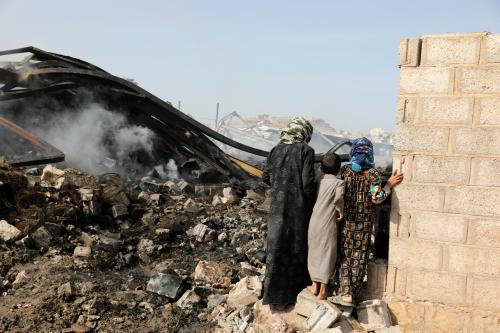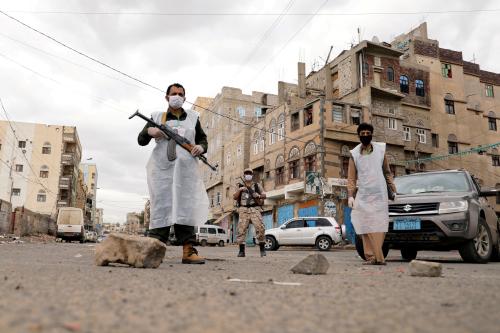The Yemeni conflict, the world’s worst humanitarian crisis, grinds on. Despite a rare exchange of prisoners, fighting in October claimed over 50 lives in the port city of Hodeida—the main conduit for aid. More died fighting in Marib and Jawf provinces. This worsened a devastating toll of 80 percent of the population—24 million people—needing humanitarian aid. Nearly half are acutely food insecure, with 2 million facing crisis levels of hunger. The COVID-19 pandemic has worsened this tragedy and the U.N. says deaths could exceed 230,000 with a death rate five times the global average. Only half of the country’s health centers are fully operational. Cholera continues to spread with 180,000 new cases reported in the first eight months of 2020. Economic activity is down by 50 percent, and the poverty rate is up to 80 percent as the middle class erodes. The 10 percent of the population reliant on remittances are seeing declines of up to 80 percent. There are 3.6 million internally displaced people (IDPs) in the country with 155,000 added in the first half of 2020. Even if the war ends in 2021, development would have been set back 25 years—40 years if it ends in 2030.
Within the broader tragedy, Yemen’s children, especially the 2 million who are IDPs, are the most vulnerable. UNICEF says 12 million need urgent humanitarian assistance. By the end of 2020, the number of malnourished children under age 5 could reach 2.4 million—half the children under 5 in the country. The mental and emotional toll has also been high with over half of children struggling with depression—with long term consequences for their future as productive individuals.
As of June 2019, over 7,500 children had been killed in Yemen since the beginning of the war due to airstrikes, shelling, mines, and other ordnance. The U.N. says current figures are worse but unreported since monitoring is increasingly difficult. Yet the toll mounts unabated and even after the much-reported 2018 death of 44 children in a school bus bombed by the Saudis, such attacks continue. As do arms sales to the Saudis from, among others, the U.S., France, and Canada. The U.N. has also documented thousands of child soldiers, most with the Houthi rebels but also with the government and other fighting forces.
Before the pandemic, 2 million children were out of school and another 3.7 million were at risk of dropping out. Girls were at greater risk with 36 percent out of school versus 24 percent for boys. Pandemic closures increased that number to 8 million. While schools have begun to slowly reopen, many children will likely stay away, some succumbing to negative coping mechanisms like child labor, child marriages, child soldiers, or other forms of exploitation. Other children are kept home for fear of infection or because parents cannot afford the cost of schooling. Prior to the pandemic, 4.7 million children needed educational assistance across the country, including 3.7 million in acute need.
Some 2,000 schools, 20 percent of the total, have been rendered unusable, either destroyed or used to house IDPs, or as centers for isolating COVID-19 patients, etc. In the past five years, 380 schools have been attacked, caught in crossfire, or occupied by fighters, including 153 hit by airstrikes from the Saudi-led coalition.
Yemen’s teachers are largely unpaid, forced to take second jobs or move on to other employment. Many try to work out of a sense of responsibility, but their situation is not tenable as evidenced by recent strikes. UNICEF needs $70 million to pay stipends to 160,000 teachers and school-based staff, less than half the total number. Lack of educational supplies and inadequate sanitation, especially for girls, remains a challenge.
Furthermore, repairing schools, furnishing educational supplies, and providing more support to teachers may not get all kids back in school. A joint World Bank and World Food Program study underlines that education is a multi-sector issue. Families reporting lack of income or those with incomes from less stable and lower paying jobs were less likely to send their children to school. Lack of access to education also overlaps with poor access to food and health. As the report notes, ”Poor health and nutrition outcomes cause children to be absent more often due to illness, participate less in class, and have lower test scores. … Improving access to health care and food would likely also promote both better school attendance and improve the quality of schooling.”
Of the $3.4 billion requested by aid agencies in 2020, only 42 percent had been received by October 2020. Aid now only reaches 9 million people a month, compared to 13 million in January 2020. Obstruction of aid delivery by Houthi authorities in the north but also to a lesser extent by the internationally recognized government and the UAE-supported Southern Transitional Council has led donors to slash funding. Numerous agencies have called for aid flows to be resumed, especially to the north but to little avail so far.
Despite these challenges, Yemeni resilience provides some hope. We see communities rebuilding their own schools, others using solar power to connect homes and schools, including women-run solar microgrid stations. Mobile phone technology and platforms like WhatsApp are used to reach more students, including for remote psychotherapy. TV and radio educational programs including community stations in rural areas are at play. There are also Yemeni institutions that have proved resilient, including the Social Fund for Development (SFD)—established in 1997 and used by donors to deliver humanitarian and development assistance. Underlining the multisector approach, perhaps a similar structure with local branches or a designated window within the SFD could provide support on blended education technology and further support to teachers and others working with children.
Without additional funds, millions of children will be at even greater risk. This is a recipe for disaster for Yemen and beyond. By now the international community knows that potential threats from millions of young people having little hope do not stay confined to national borders. In speaking of children and the trauma of war, psychologist Michael Wessells says, “One of the greatest effects I see … is a loss of hope. Once young people feel hopeless, they really do give up. They don’t take steps that might build a constructive future.” This will not only prevent stabilization within their country, but with the dangers of radicalization, criminality, or becoming mercenaries, they can destabilize whole regions, near and far. Now is the time to act.






Commentary
Yemen’s children: A crisis within a crisis
November 19, 2020